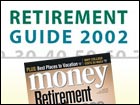
If you're in your fifties or early sixties, preparing for retirement can be a schizophrenic pursuit.
You need to invest aggressively enough to make up for any losses or lack of planning, yet conservatively enough to preserve the wealth you've accumulated so far. That tug and pull is even more pronounced in this market.
But even if you've lost ground, now is not the time to be overly aggressive. "People in their fifties and sixties can't afford to take huge risks this close to retirement, no matter how far behind they may feel," says Robert Bingham, founding partner of San Francisco wealth-management firm Bingham Osborn & Scarborough.
So how do you meet your needs? The answer is careful planning. Here's how to go about it.

"Catch up" in your 401(k) The catch-up provisions in the 2001 tax law are designed for vigorous savings. And they're quite a bonus. Employees 50 and older can save an additional $1,000 in their 401(k), 403(b) or 457 plans in 2002, on top of this year's new $11,000 contribution limit for all workers.
That catch-up amount increases by $1,000 a year until 2006, when employees 50 and older can stash $20,000 in their workplace plan. Beyond 2006, both the standard limits and the catch-up provisions for all plans will be adjusted annually for inflation.
The new rules also loosen the limits on the pretax dollars that can be put into your plan. Previously, your retirement contributions plus your employer's match and other pretax benefits such as profit sharing could not total more than 25 percent of your compensation each year. The new rules allow a maximum of 100 percent of compensation or $40,000, whichever is less.
For two-earner couples trying to catch up, this may allow one spouse to put away a huge chunk of his or her salary for retirement. (As with all the new contribution rules, you can take advantage of the catch-up provisions only if your employer has agreed to offer them.)
Even with a relatively short 15-year time frame, that extra stash can make a big difference. If you put away the additional sum every year beginning at age 50 and earn an 8 percent annual return, you could boost your nest egg by more than $200,000 before taxes, according to T. Rowe Price.
"Catch up" in your IRA Older workers can also make much more generous IRA investments. This year, the maximum contribution to all types of IRAs went from $2,000 to $3,500 for anyone 50 or older. The IRA cap increases over the years, reaching $6,000 for those 50 and older in 2008.
That means if you are able to take full advantage of the catch-up rules in your 401(k) and your IRA, you'll be able to put away $15,500 this year tax deferred; by 2008, that number will be $26,000.
The bottom line? If you're a 50-year-old and can fully fund both accounts, you can retire with an estimated $300,000 more than you could have saved tax-free before last year's tax-rule changes.
Consider working more Saving more is the obvious first step if you've undergone some devastating stock market losses recently and think you'll fall far short of your retirement goal.
But there's another option: working longer. It's a choice more and more employees are considering. According to a recent survey of high-income investors by Quicken.com, 13 percent of respondents said they are planning to retire later than they originally intended, and more than one-third of those said they would work five extra years or longer.
Assuming you can stay on at your job and continue to contribute to your firm's retirement plan, just five extra years of pouring the maximum into your 401(k) can add almost $100,000 to your portfolio, assuming an 8 percent annual return, according to T. Rowe Price. Staying at work when you thought you'd be off seeing the world could mean a major adjustment, but numbers like that might make the delay worthwhile.
Merge plans In addition to the higher contribution caps, there are some other less-publicized tax-code changes that, indirectly, could help savers trying to make up for lost money or lost time.
The new rules make retirement money more portable than ever. And that's especially important later in your career, when job changes may have left you with multiple retirement accounts scattered among different corporate benefits departments and financial institutions.
Now you'll be able to consolidate more of these accounts, making them easier to track and manage. And if you have money trapped in a plan with high fees or poor investment choices, it's now more likely that you can liberate it.
| Retirement Toolkit
|

|
|
|
|
Starting in 2002, you can roll all 401(k), 403(b) and 457 accounts from previous jobs into an IRA or your current employer's plan if the company permits. And IRAs may be rolled into company-sponsored plans -- again, if the plan allows.
Previously, you could not roll over after-tax 401(k) contributions or nondeductible IRAs into a new employer's plan. The new rules are especially good for government employees with old 457 plans, which could formerly be rolled over only into another 457.
Invest for stability Once you've consolidated your accounts and upped your savings, one question remains: What's the best way to invest at this stage? If you've suffered big losses, the temptation may be to try for a big, fast payoff. But now is the time for thoughtful diversification and a steady hand.
Take Ken Parent, 52, an insurance consultant from Suffield, Conn. After suffering losses in Janus Mercury (down 23 percent in 2000) and Janus Olympus (down 22 percent), Parent and his wife Therese, 50, took a long, hard look at their retirement portfolios with an eye toward stability. "We've switched from a growth- to a value-based approach, and we got rid of some funds that were overlapping so we'd be more diversified," explains Parent. "We couldn't bear to look at our investments -- there was just too much bad news," he adds. "I don't ever want to go through that again."
Like Parent, once you hit your fifties you'll want to diversify your equity holdings among growth and value, small-caps and large-caps and international stocks. In addition, you should gradually move more toward a 35 percent allocation in a variety of fixed-income investments.
As you rejigger your portfolio, you may want to sell some of your underperforming stocks and funds, especially if you've lost faith in them, and use that money to finance fresh retirement savings. The silver lining? You'll be able to offset any capital gains, and write off up to $3,000 in remaining losses against ordinary income.
It's important to diversify your fixed-income holdings as well. To do that, consider stable-value funds to complement your individual bonds and bond funds. These fixed-income funds typically deliver returns equivalent to intermediate-term bond funds, with the stability of money-market funds. They are offered in most 401(k)s, although they may be called by another name, such as a capital-preservation fund or income fund. Stable-value funds invest mainly in guaranteed income contracts -- which promise a rate of return for a specified length of time, usually 21/2 years -- and also hold high-quality bonds and other interest-paying vehicles.
Over the past 12 months, the average stable-value fund has returned 6.3 percent. Typically, these funds fluctuate less than one-quarter of one percentage point a year, thus living up to their name.
Bail out of company stock When you're looking at allocations, be sure to add up what portion of your portfolio is in company stock. After Enron, no one needs reminding of just how risky a heavy exposure can be. Fortunately, age 50 or 55 is usually the time most corporations allow employees to start reallocating company stock held in their retirement plans.
"Be sure to look at your 401(k), but also any company stock you might have in employee purchase plans or incentive stock options," says Donn Sharer, a vice president at MetLife financial services. "It's easy to ratchet up your position in company stock to the point where it accounts for more than half of your net worth." If that's the case, now is the time to get out.

|

